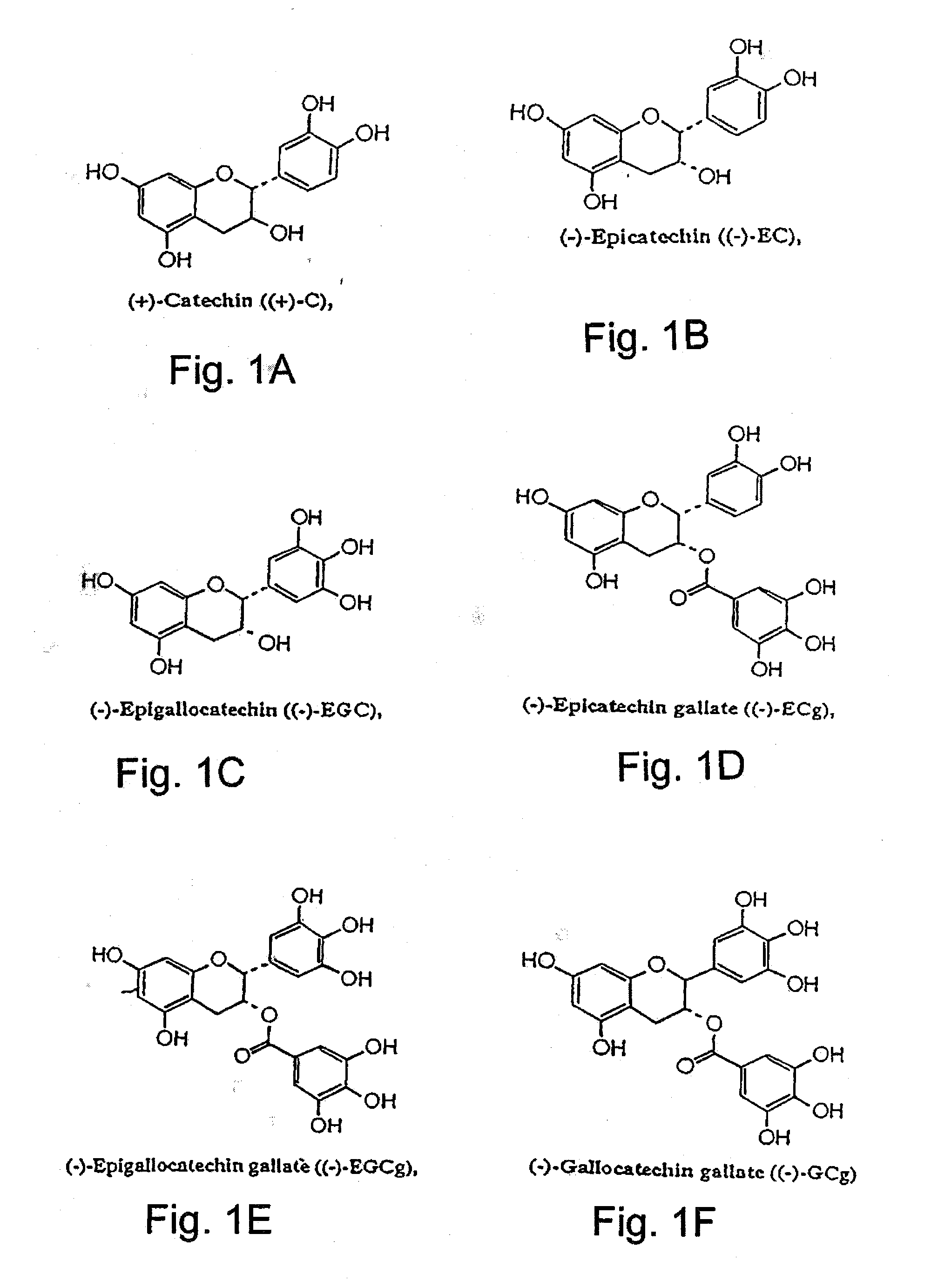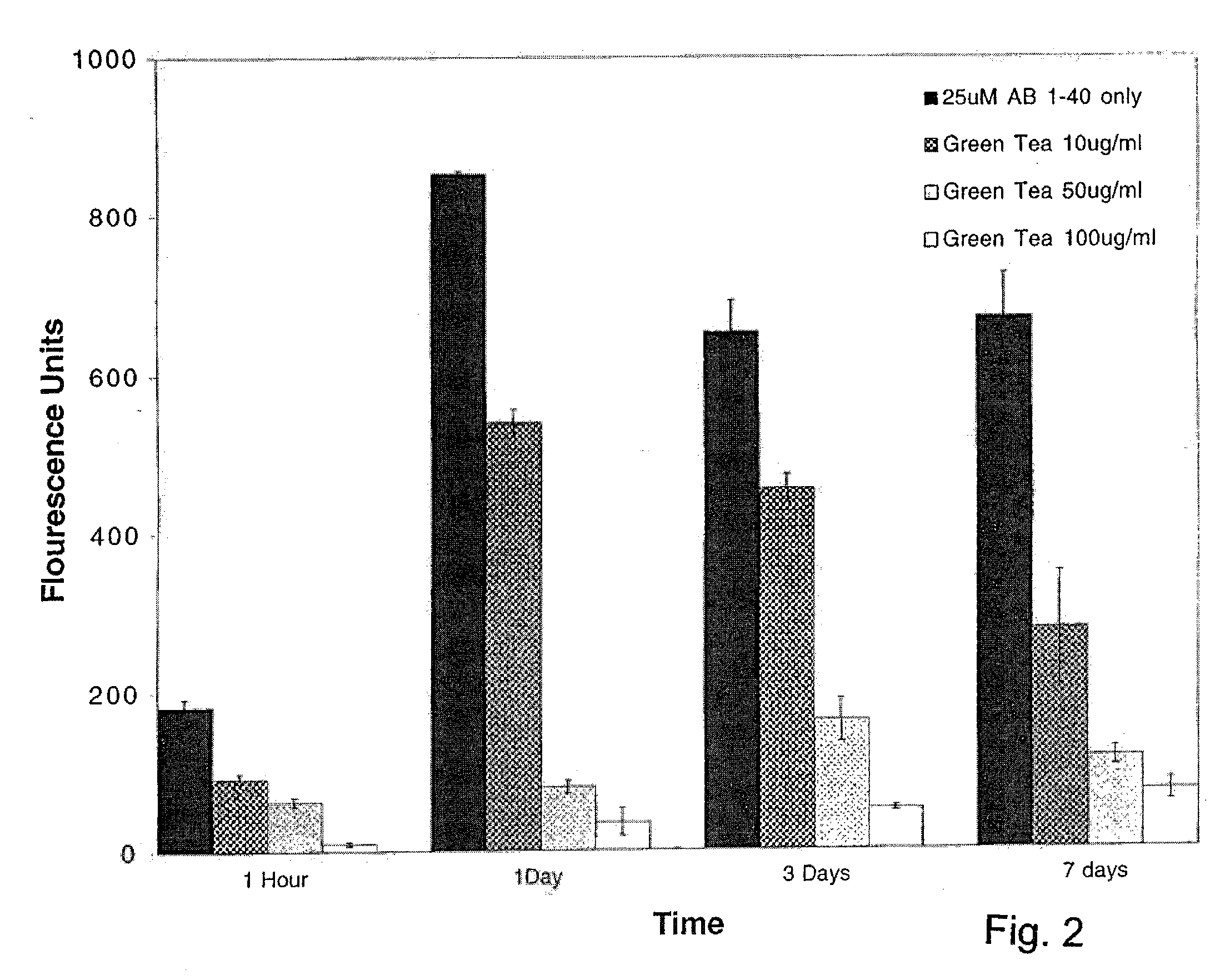Cathechins for the treatment of systemic aa amyloidosis
a technology of amyloid fibrils and cathechins, applied in the direction of biocide, plant/algae/fungi/lichens ingredients, drug compositions, etc., can solve the problems of toxic and neuronal cell death, no cure or effective treatment, etc., to reduce, eliminate, inhibit, disassemble or disaggregate amyloid fibrils or protein deposits, and promote mental alertness , the effect of promoting mental alertness
- Summary
- Abstract
- Description
- Claims
- Application Information
AI Technical Summary
Problems solved by technology
Method used
Image
Examples
example 1
Standardized Green Tea Leaf Extract is a Potent Inhibitor of Alzheimer's Aβ (1-40) Amyloid Fibril Formation
[0153]A previously described method of measuring amyloid fibril formation utilizing Thioflavin T fluorometry (H Naiki et al, Lab. Invest. 65:104-110, 1991; H Levine III, Protein Sci. 2:404-410, 1993; H Levine III, Amyloid: Int. J. Exp. Clin. Invest. 2:1-6,1995; H Naiki and K. Nakakuki, Lab. Invest. 74:374-383, 1996) was employed initially to identify whether standardized green tea leaf extract was capable of inhibiting Alzheimer's Aβ amyloid fibril formation. Using this sensitive assay, any decreases or increases in fluorescence was previously shown to correlate with a decrease or increase in the amount of amyloid fibrils (H Naiki et al, Lab. Invest. 65:104-110, 1991; H Levine III, Protein Sci. 2:404-410, 1993; H Levine III, Amyloid: Int. J. Exp. Clin. Invest. 2:1-6, 1995; H Naiki and K. Nakakuki, Lab. Invest. 74:374-383, 1996), allowing one to determine the effects of potentia...
example 2
[0158]Disassembly / Disruption of Alzheimer's Disease Aβ 1-42 Amyloid Fibrils by Standardized Green Tea Leaf Extract
[0159]In the next study, standardized green tea leaf extract was tested for its ability to cause a disassembly / disruption of pre-formed Alzheimer's disease amyloid fibrils containing Aβ 1-42. This type of activity would be important for any potential anti-amyloid compound which can be used in patients who already have substantial amyloid deposition in organs and / or tissues. For example, Alzheimer's disease patients in mid-to-late stage disease have abundant AG-containing amyloid deposits in their brains as part of both neuritic plaques and cerebrovascular amyloid deposits. A compound capable of causing disassembly / disruption of pre-existing amyloid deposits would be advantageous for use in these patients who are at latter stages of the disease process.
[0160]For this study, 1 mg of Aβ1-42 (Sachem Inc., Torrance, Calif., USA; Lot #516817) was dissolved in 1.0 ml of double ...
example 3
Disaggregation of Alzheimer's Disease Aβ 1-42 Fibrils by Standardized Green Tea Leaf Extract
[0165]In the next study a Congo red-Aβ spectrophotometric assay (Klunk et al, Anal. Biochem. 266:66-76, 1999) was modified to determine the effectiveness of standardized green tea leaf extract on disaggregation of Alzheimer's Aβ 1-42 amyloid fibrils. For this assay, 25 μM of Aβ 1-42 (Bachem Inc., Torrance Calif., Lot #516817) was incubated in triplicate for 4 days in distilled water at 37° C. in the absence or presence of 400 μg / ml of standardized green tea extract (obtained from two commercial sources) in Tris-buffered saline (TBS)(100 mM Tris; 50 mM NaCl; pH 7.0, with 0.02% sodium azide). The Aβ:green tea extract weight ratio was 1:4. Source 1 of the standardized green tea extract used in this study was from Sundown Herbals (manufactured and distributed for Sundown Vitamins, Boca Raton, Fla.), whereas source 2 of the standardized green tea extract used in this study was form Nature's Resour...
PUM
| Property | Measurement | Unit |
|---|---|---|
| flow rate | aaaaa | aaaaa |
| concentration | aaaaa | aaaaa |
| pH | aaaaa | aaaaa |
Abstract
Description
Claims
Application Information
 Login to View More
Login to View More - R&D
- Intellectual Property
- Life Sciences
- Materials
- Tech Scout
- Unparalleled Data Quality
- Higher Quality Content
- 60% Fewer Hallucinations
Browse by: Latest US Patents, China's latest patents, Technical Efficacy Thesaurus, Application Domain, Technology Topic, Popular Technical Reports.
© 2025 PatSnap. All rights reserved.Legal|Privacy policy|Modern Slavery Act Transparency Statement|Sitemap|About US| Contact US: help@patsnap.com



